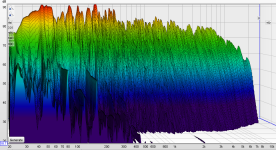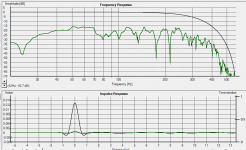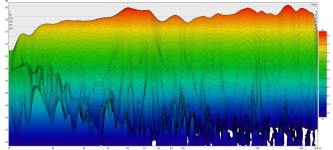Experimental assessment of low-frequency electroacoustic absorbers for room modal... | Request PDF
I requested the article and got it. (Not AES member)
Looks like they also try other methods. Look at the article indexes of the authors.
I requested the article and got it. (Not AES member)
Looks like they also try other methods. Look at the article indexes of the authors.
Torgeirs
Reading carefully, the "passive" paper has mixed results. It uses four large drivers, in a very small room with virtually no damping. So this is clearly a "best case" scenario. The measured results are taken very close to one of the dampers - not really fair. The global loss in one case was about 2 dB - in a very reverberate space - or about 1/2 dB per source. This isn't really very appealing.
Now active I would expect to be very effective if done right. That might be appealing, but not so low cost. I suppose in European rooms this might be appealing, but here, not so much.
Reading carefully, the "passive" paper has mixed results. It uses four large drivers, in a very small room with virtually no damping. So this is clearly a "best case" scenario. The measured results are taken very close to one of the dampers - not really fair. The global loss in one case was about 2 dB - in a very reverberate space - or about 1/2 dB per source. This isn't really very appealing.
Now active I would expect to be very effective if done right. That might be appealing, but not so low cost. I suppose in European rooms this might be appealing, but here, not so much.
Yes, seems like small rooms with concrete/hard walls. And room dimentions creating problems/booming in the 70 to 100 hz region is best suited.
But, if that is the case, it may bee a cheap help both on noise and sound quality
Even if over all noise is not much dampened because of small bandwith. This is a region that is very annoying and not very well masked by other sound sources
But, if that is the case, it may bee a cheap help both on noise and sound quality
Even if over all noise is not much dampened because of small bandwith. This is a region that is very annoying and not very well masked by other sound sources
Last edited:
Back to my first question :
I think that found one explanation after a nice discussion with somebody who was active in the development of the AVAA from PSI : this active absorber is a nice tool to understand some acoustics because you can easily compare and measure when switching it on/off.
My explanation : when you place this absorber or a passive resonator or absorbant in a corner (ie anything that has some acoustic inluence in low frequencies), this "absorber" can be considered as a re-radiating item. Generally its dimensions are smaller than the low frequencies wavelengths concerned. Due to the small dimensions, the directivity of the re-radiation is wide and so will influence and distord the original soundfield everywhere in the room.
Does this make sense ?
Hello jlo. The active absorber by psiaudio reminds me of that described by Nelson S. Pass [inventor] in his US patent 4,899,387. Are you aware of recent and pertinent patents by psiaudio; because they have to build upon the Pass patent?. I experimented with such absorbers. They remove bass energy out of the room. Readily discernible.
I sit in a room corner [acoustically filthy] and listen sequentially to the active absorber enabled and not. Its cleaning performance is readily discerned. Consider using the song for this test called Water under the bridge by Adele 25.
Any active absorber must not radiate energy back into the room as gedlee has already replied.
Thanks to the authors/participants of this interesting and educating thread.
Another way to ask your question might be: can I equalise the bass to my listening position and ignore the modes..
The answer is, "yes" according to a detailed study undertaken by Todd Welti for Harman Int'l. One of the low frequency optimization goals was "Get lots of output, with flat frequency response over a defined listening area."
It seems to me that strategic placement of 2 or 4 woofers is much more practical for the average diyer than spending thousands of dollars acoustically isolating an extra layer of wallboard then taping and painting 2 opposing walls, especially if the result is close, equal to or better than the wall upgrade.
As a matter of fact, that option isn't even available to audiophiles like myself who have windows and sliding glass door along one side of the room, and no back wall because the room opens into the kitchen.
The first time I heard about this theory was reading about The Swarm Subwoofer System sold by Duke LeJune of Audio Kinesis.
As an update from my part (mostly regarding usage of electroacoustic absorbers), I went beyond using only one method to get good bass in my room. I supplemented the existing two big Hofa's (functional bass trap type) with two EQ Acoustics panels (membrane bass trap type) and increase the number of multiple subwoofers from two to five. The improvement is so substantial that I can call for armistice and will resist spending more on either acoustic treatment or subwoofers because I want my room looks like a home, not a recording studio.
I tested all the hard bass tracks I knew or recommended by others and on neither one I found any trace of "instability", all sounded as they should (I'll come back with a waterfall I did on that occasion).
Regarding the effect of a passive electroacoustic absorber, I observed that it is so diminished after I increased the number of usual bass traps and subwoofers. To the level it becomes indiscernible. As long as my room was untreated it was quite discernible, not the case now.
I tested all the hard bass tracks I knew or recommended by others and on neither one I found any trace of "instability", all sounded as they should (I'll come back with a waterfall I did on that occasion).
Regarding the effect of a passive electroacoustic absorber, I observed that it is so diminished after I increased the number of usual bass traps and subwoofers. To the level it becomes indiscernible. As long as my room was untreated it was quite discernible, not the case now.
Last edited:
How have you arranged them, mono, I presume, and have you EQd them?increase the number of multiple subwoofers from two to five.
I supplemented the existing two big Hofa's (functional bass trap type) with two EQ Acoustics panels (membrane bass trap type)
Could you be more specific about "the membrane bass trap" you have chosen. A link, spec would be greatly appreciated
@jcga
These are the membrane traps, nice build and easy to hang on the wall:
EQ Acoustics Spectrum Trap 50L Natural – Thomann România
But more effective are the Hofa's:
Hofa Basstrap Creme – Thomann România
take much more space but could be used as support for equipment etc.
@scott
Indeed, mono under 100Hz and two "mild" parametrics on 51Hz and 61Hz.
Positions, as staying on the couch were:
- one in front, between the mains, in phase.
- one in front, left-upper corner, in phase.
- two identical, left wall (~2/3 wall lenght) and right wall (~1/3 wall lenght), both in phase.
- one on rear wall, right corner (better in the middle but poor WAF), in phase (if put in antiphase then 25Hz dip disappears but interval 25Hz-50Hz decreases).
I put two graphs; on waterfall, do not mind those 80Hz and 160Hz noises caused by an autogenerator in nearby building which got tested for an hour just when I did my experiments
These are the membrane traps, nice build and easy to hang on the wall:
EQ Acoustics Spectrum Trap 50L Natural – Thomann România
But more effective are the Hofa's:
Hofa Basstrap Creme – Thomann România
take much more space but could be used as support for equipment etc.
@scott
Indeed, mono under 100Hz and two "mild" parametrics on 51Hz and 61Hz.
Positions, as staying on the couch were:
- one in front, between the mains, in phase.
- one in front, left-upper corner, in phase.
- two identical, left wall (~2/3 wall lenght) and right wall (~1/3 wall lenght), both in phase.
- one on rear wall, right corner (better in the middle but poor WAF), in phase (if put in antiphase then 25Hz dip disappears but interval 25Hz-50Hz decreases).
I put two graphs; on waterfall, do not mind those 80Hz and 160Hz noises caused by an autogenerator in nearby building which got tested for an hour just when I did my experiments
Attachments
Last edited:
A couple months ago Dr. Geddes gave this answer about LF treatment. I hope it is not too late for a further question.Hang two sheets of drywall on resilient channel and glue them together with a non-hardening damped glue, i.e. constrained layer damping. They must float so seal the edges with a soft material. (And no shorting screws please! I screw the layers together until the glue dries and then remove them.) These large panels will be great LF absorbers. Also remember that at LFs it is only necessary to dampen on of any two opposing surfaces. One wall acts exactly the same as two walls in the modal region.
We are used to see everywhere in the Web those ceiling traps built as framed rockwool panels, spaced from the actual ceiling and covered in fabric.
The same devices are seen also on walls.
I understand the need for wideband absorption at first reflection points but, apart of it, should them be replaced by drywall panels attached to resilient channels, as explained above ?
I mean a ceiling with flat drywall "islands" instead of hanging rockwool boxes.
It would be a very different approach.
Thanks
Excellent article on bass management
This is one of the best articles on the subject that I've found.
This is one of the best articles on the subject that I've found.
I would advice to zoom in the waterfall between something like 20-350 Hz and use 5 dB increments. See example below.@jcga
I put two graphs; on waterfall, do not mind those 80Hz and 160Hz noises caused by an autogenerator in nearby building which got tested for an hour just when I did my experiments
Either way, looks like you have a lot of resonances.
Attachments
Last edited:
That article makes a couple of references to filling in dips with EQ, sorry, that can't be done.
I found a lot more useful information in the article than the one point you've referred to. EQ is a choice and not the only way to achieve the goal.
- Status
- This old topic is closed. If you want to reopen this topic, contact a moderator using the "Report Post" button.
- Home
- General Interest
- Room Acoustics & Mods
- Acoustics of corners


